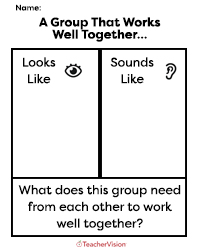
-
 By Julie Mason
By Julie Mason
Julie shares why she prioritizes co-creating classroom expectations with her students, and how revising those expectations has improved her classroom management and boosted her teaching confidence. Julie breaks down how the expectation setting process works, and shares her tips for getting started.

How Important is Setting Classroom Expectations?
I think most of us would agree that it is important. Routines and procedures are at the heart of strong classroom management, and the school year often begins with setting class expectations for the year to come.
But, how often do we revisit expectations?
As teachers, we are constantly confronting a long list of demands. There is so much we want to do, but there is also so much we need to do. Even when we believe strongly in the importance of something, we have to weigh it against a long to do list. We can’t do it all, so we have to choose wisely.
So what do we prioritize?
"The longer I taught, the more I developed confidence that the choices I prioritized in my classroom honestly reflected the teacher I hoped to be."
I value student-centered classrooms where my students know they have voice, choice, and agency over their learning experience. Creating a strong classroom community was important to me, so I prioritized spending time co-creating and revising expectations throughout the year.
Each year that time increased, and each year my classroom management grew stronger. I believe that my management was stronger because I created a routine, I consistently followed that routine, and I invited my students to participate in the process.
Teachers learn best from other teachers. I believe the more we can share our best practices and resources, the more excited we are about teaching. Here is the routine I developed. Modify it as needed so it works for your classroom and builds on the great work you have already done this school year.
Co-Creating Classroom Expectations
We all know that an essential step in establishing routines and procedures in September is creating expectations for your classroom and your students. It is helpful for students to know what behaviors they will be held accountable for. In my teaching, I found that students were more likely to follow the expectations when we created them together. The process looked something like this:

This allowed me to activate students’ prior knowledge and connect the task to their real-world experience.
I then asked students to share out, and I collected their ideas on a piece of chart paper. As a class, we developed a list of expectations that we agreed were important in order for us to work well together and maximize our learning.
Here is what we came up with:
- Stay In Your Own Lane
- Ask For Help
- Follow Through
- Listen and Speak Up
We then used the Looks Like/Sounds Like graphic organizer again to develop a set of criteria for each expectation. I asked students, “what does it look like when you follow through?” “What does it sound like when you ask for help?” These guiding questions led to a collective discussion.
The work didn’t end there; we revisited these expectations again mid-year and several times after that. I encouraged students to use a self-assessment scale to identify if they were meeting the expectation or not. I would also poll the class and ask students to assess the class as a whole.
1= Not Meeting Expectations
2= Meeting Some Expectations
3=Meeting Most Expectations
4=Meeting All Expectations
When I surveyed my students about their experience with this process, they shared that they felt the expectations were very clear because we developed them together. Most students strongly agreed that they felt their voices were represented in the process. I asked them what they thought would make the process better, and incorporated their changes.
"Every routine I created in my classroom wasn’t always this successful. I believe the reason this routine succeeded was that it reflected the type of teacher I hoped to be, and was becoming."
5 Tips For Getting Started
1. It's Never Too Late To Set Expectations
Full disclosure: My first few years of teaching I either didn’t set clear expectations or I didn’t use them consistently in my classroom. Time is our biggest barrier as teachers, and if you are reading this post and thinking: I should probably set some expectations or I can’t remember what my expectations are, don’t worry! It is never too late to set expectations and January is an ideal time to pause, find some time in your schedule, and brainstorm with your students.
2. Expectations Evolve With Your Students
Chances are that your students have grown and evolved since you first established expectations in September. January is an ideal time to give your students the opportunity to assess their progress as a class. If the class is able to identify that they successfully asked for help, that expectation might be removed from the list because it is something that students intuitively do.
3. Revisiting Expectations Leads to New Expectations
Self-Assessment leads to self-awareness. When the class evaluates their progress, you may realize that new expectations are needed and add them to the list. For example, if students worked on a project during December and the class struggled to stay on task, then a revised expectation might include staying focused and accountable. Once a new expectation is agreed on, it can be helpful to support students to set goals. This Setting SMART Goals Worksheet is one of my favorite goal setting resources. Now students have something to work on, and you have something for them to self-assess throughout the month.
4. Make Revised Expectations Visible
Find a place in your classroom to create an anchor chart with the expectations. If you use an LMS like Google Classroom, create a doc where students can easily access them. More importantly, refer back to them. Name positive examples of students meeting expectations when you see them in class. When you redirect students or need to address their behavior, refer back to them so everyone is on the same page. The more consistent you are in using the expectations, the more students will be reminded what they are.
5. Save The Date To Revise Again
Block time on your calendar to revisit expectations again in a month. Consider choosing one day/week when you can provide students with time to self-assess how they are doing with the expectations. You can also consider blocking some time each week for the class to check in and evaluate how effectively they are (or aren’t) meeting expectations.
Inviting students into the process of revising and creating expectations keeps classroom rules timely and relevant. By engaging in this conversation, you are making students’ progress visible, acknowledging their growth, and supporting them to see areas for improvement. For more on this topic and ideas for expectations, check out, Students' Contributions To The Rules and The 5 P's: Meaningful Classroom Rules.
Share your favorite morning routine tips with us on Instagram, Facebook, Twitter, Pinterest, and Google+.
Author Bio:
Julie Mason is the Head of Curriculum and Content for TeacherVision. She taught middle and high school English for eight years, and then worked as an instructional coach, supporting K-12 teachers to blend and personalize their classrooms.
